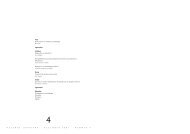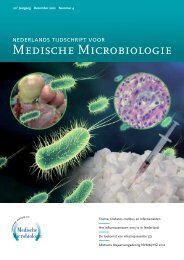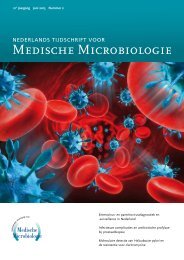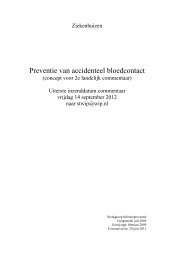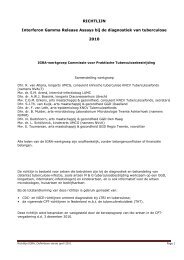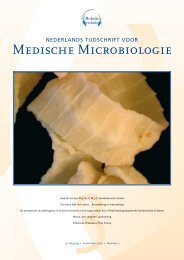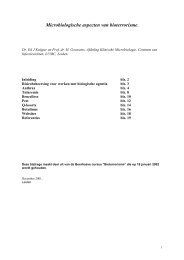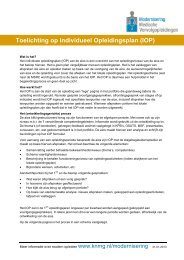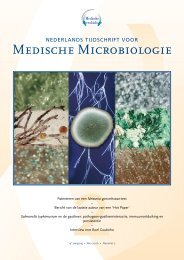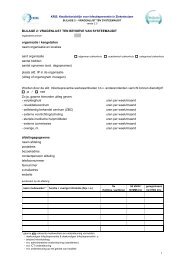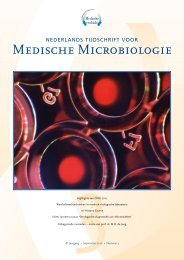Supplement bij veertiende jaargang, april 2006 - NVMM
Supplement bij veertiende jaargang, april 2006 - NVMM
Supplement bij veertiende jaargang, april 2006 - NVMM
You also want an ePaper? Increase the reach of your titles
YUMPU automatically turns print PDFs into web optimized ePapers that Google loves.
choice. Other drugs like amphotericin B and voriconazole<br />
should be considered.<br />
02.11<br />
Black fungal infections in China<br />
Ruo-yu Li<br />
Department of Dermatology, Peking University First Hospital,<br />
Research Center for Medical Mycology, Peking University,<br />
Beijing, China<br />
The black fungi are a large and heterogenous group of<br />
filamentous moulds with dark colored colonies and cell<br />
walls. They could produce brown melanin or melanin-like<br />
pigment in the cell wall of their hyphae or conidia, or both.<br />
Clinically, black fungi could cause the following diseases:<br />
chromoblastomycosis; phaeohyphomycosis; eumycotic<br />
mycetoma; onychomycosis; tinea nigra; black piedra and<br />
mycotic keratitis. Chromoblastomycosis is a distinctive<br />
infection of the skin and subcutaneous tissues caused<br />
by several dematiaceous moulds. It is the most common<br />
black fungal infection in China. The causative agents were<br />
Cladophialophora carrionii (64.7%), Fonsecaea pedrosoi<br />
(24.6%), Phialophora verrucosa (2.4%) and Fonsecaea<br />
compacta (0.8%). Phaeohyphomycosis is a generic term<br />
to be applied to any mycosis involving a dematiaceous<br />
fungus. The pathogenic agents of phaeohyphomycosis<br />
are widespread in the environment include soil, wood,<br />
decomposing plant matter as well as polluted water.<br />
Until 1998, 60 genera, 109 species were reported to be<br />
human pathogenic. The causative agents in China mainly<br />
included: Exophiala spp. (most common), Chaetomium spp.,<br />
Bipolaris spinifera, Alternaria alternata, Veronaea botryosa,<br />
Ochroconis gallopavum, Curvularia clavata, Phialophora<br />
verrucosa, Hendersonula toruloidea. The treatment of black<br />
fungal infection is still difficult. In summary, chromoblastomycosis<br />
is the major type of dematiaceous fungal<br />
infection in China. Phaeohyphomycosis is increasing in<br />
immunocompromised patients and the management of<br />
it still challengeable. The classification and identification<br />
of dematiaceous fungi will depend on the combination of<br />
morphological, physiological, molecular biological as well<br />
as other supplementary methods.<br />
02.12<br />
Colonization of cystic fibrosis patients with Aspergillus<br />
fumigatus is a recurrent phenomenon<br />
H.A. de Valk, I.M. Curfs, C.H.W. Klaassen, J.F.G.M. Meis<br />
Canisius Wilhelmina Hospital, Medical Microbiology and<br />
Infectious Diseases, Nijmegen<br />
Introduction: Aspergillus fumigatus strains often colonize<br />
the respiratory tract of Cystic Fibrosis (CF) patients.<br />
Ned Tijdschr Med Microbiol <strong>2006</strong>; 4:<strong>Supplement</strong><br />
S2<br />
Previous low discriminatory molecular typing assays<br />
suggested the majority of sequential cultured isolates to<br />
be of the same genotype. We used a novel high-resolution<br />
fingerprinting assay to analyze multiple A. fumigatus<br />
strains from CF patients.<br />
Methods: We collected A. fumigatus strains from nine<br />
patients. From 6 patients each, two isolates were collected<br />
with a one year interval. From 3 patients, isolates were<br />
collected over a period of 3 to 4 years (3, 16 and 13 isolates<br />
respectively). All strains were analyzed using the STRAf<br />
(Short Tandem Repeats of A. fumigatus) assay.<br />
Results: From 6 patients, all intrapatient, isolates were<br />
of different genotypes. One patient with two isolates was<br />
colonized by the same strain over a period of one year. From<br />
the patient with 16 isolates, 13 different genotypes were<br />
found; two types were isolated more than once within a 5<br />
months period. The patient with 13 isolates harbored four<br />
unique isolates and 3 clusters of 3 isolates were from the<br />
same type and succeeded each other during the last year.<br />
Conclusion: Over a long period of time, different genotypes<br />
of A. fumigatus were found in most of the examined CFpatients.<br />
If the same genotype was found more than once,<br />
this only occurred in a short time period. Airway colonization<br />
of CF patients with A. fumigatus is appear to be a<br />
recurrent event. To substantiate this further more isolates<br />
from more CF patients should be analyzed.<br />
02.13<br />
epidemiologic issues in invasive fungal infections<br />
David W. Warnock<br />
Division of Bacterial and Mycotic Diseases, Centers for Disease<br />
Control and Prevention, Atlanta, Georgia, U.S.A.<br />
The last two decades have seen unprecedented changes in<br />
the pattern of serious fungal infections among immunocompromised<br />
individuals, including hematopoietic stem<br />
cell transplant (HSCT) and solid organ transplant (SOT)<br />
recipients, persons with hematological malignancies,<br />
and persons living with AIDS. These infections are being<br />
seen in ever increasing numbers, largely because of the<br />
increasing size of the population at risk. Although gains<br />
have been made in the treatment and prevention of some<br />
fungal infections, medical developments and changing<br />
health care practices have contributed to the emergence of<br />
new pathogens, and new at-risk groups.<br />
Sentinel and population-based surveillance programs<br />
have documented significant changes in the rates of<br />
invasive candidiasis (IC) among different groups of<br />
immunocompromised patients, with the emergence<br />
of non-albicans Candida species, particularly Candida<br />
glabrata, as important pathogens. More cases of IC now<br />
occur among critical care patients than are diagnosed<br />
among neutropenic cancer patients or HSCT recipients.



